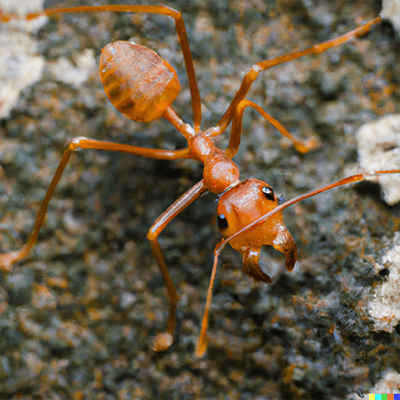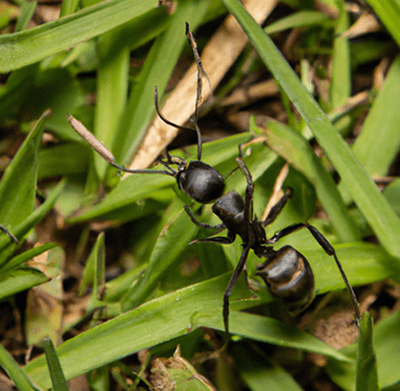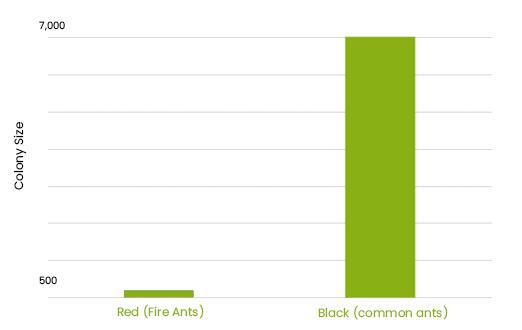
Created By
Matt Adams
Updated On
- March 1, 2024
Get FREE Exclusive Access
Keep your lawn pristine with exclusive tips, offers and insights that I only share with my private subscribers.
Latest Posts
How to remove ants nest in your lawn – WITHOUT harming the grass
- By Matt Adams
- March 1, 2024
Jump to
Get FREE Exclusive Access
Keep your lawn pristine with exclusive tips, offers and insights that I only share with my private subscribers.
Have you ever wondered why ants seem to just pop up in your lawn out of nowhere? Well, I’m here to give you some inside info on this very subject.
In this article I’ll explain why they come, how to remedy the problem and how to prevent them returning. I’ll even give a quick overview of the difference between red (Fire) and black (normal) ants.
So, let’s go.
Why the heck do they do they appear in my lawn?
Ants are like nature’s cleanup crew, scavenging for food everywhere they go.
They want sugary substances, fallen fruits, and other tasty treats that might end up on your grass.
Maybe you don’t have any of the above in your garden and your still wondering why they’re here,
In fact, they like to nest in lawns with shorter grasses that have dry, loose soil.
The shorter grass makes it easier for them to forage and gather food. So, if you’re keeping your lawn trim and tidy, you might inadvertently be inviting these six-legged guests over for a meal.
Ants are also picky about the location of their houses. They’re quite skilled at building nests, and they prefer loose, well-drained soil that’s easy to tunnel through. If your lawn provides this kind of soil, it’s like an invitation for them to set up camp. You might notice small mounds of soil or sand on your lawn where they’ve made their nests.
So, in a nutshell, ants appear in your lawn for 2 main reasons
- It offers them a gourmet dining experience
- Your soil is a prime location for their ‘house’ or nest
Just remember though, while they might be a bit of a nuisance, ants do play an essential role in ecosystems.
So, my preference is always to prevent or resolve these types of problems with natural means rather than harmful remedies.
Not all ants are the same though and here’s why.
Types of ants you can get on your lawn (Red vs Black)
There are actually 9 types of ant species here in the UK. But if you’ve landed on this article, you’ve probably got one of 2 types invading your garden.

Either Red or Black!
The black ones you’ll see scavenging for food, building their nests, and going about their ant business. They might be a nuisance, but they usually don’t pose a major threat.

On the other hand, red ants, commonly referred to as fire ants, are a bit more infamous. They’re known for their reddish-brown colour and come with a painful sting.
Unlike your common species, fire ants are aggressive and territorial. If you step too close to their nest or disturb them, they’ll attack in force, causing a burning sensation when they bite or sting.
Their stings can even be dangerous for individuals with allergies. So, I urge you to take more caution when dealing with these species.
Their different nesting habits and colony sizes

Another key difference is their nesting habits. Regular ants typically build their nests underground or in logs, while fire ants create large, noticeable mounds above the ground.
These mounds can be quite an eyesore in your lawn and can be a sign of a fire ant infestation.
As you can see from the graph below, red ones come in much smaller colonies of around 100-300. So, while they can be more harmful, they might be easier to get rid of than a 7,000 strong black ant colony.

Do they actually eat the grass?
So, here’s the truth.
Ants don’t actually nibble on your grass like a rotary lawn mower gone crazy. They’re not there for that. Instead, they are after the sweet stuff – think fallen fruit, sugary substances, and crumbs.
They’re more like dessert hunters than grass grazers.
So, while ants might be roaming around your grass, they’re not the culprits if you spot any chewed-up blades. It’s all about the sugar rush for them!
How to prevent the ants from returning (and coming in the first place)
Understanding how to prevent them from invading your garden (and home) means you won’t need to kill them off. Thus protecting more of our lovely UK wildlife.
Preventing ants from invading your home and lawn involves a combination of cleanliness, proactive measures, and making your space less attractive to build their nests.
Here are some effective strategies to keep ants at bay:
- Outdoor Maintenance: Trim vegetation away from your house, as branches and leaves can provide bridges for ants. Regularly clean outdoor trash cans to remove potential food sources.
- Remove Attraction: Ants are after food and water. Fix leaky faucets and plumbing, and ensure proper drainage. Keep pet bowls clean and remove any leftovers.
- Ant-Repellent Plants: Plant ant-repellent herbs like mint, basil, or lavender around your home’s entry points. Ants tend to avoid these fragrances.
- Natural Barriers: Create a barrier around your lawn using substances ants dislike, such as cinnamon, coffee grounds, or chalk. Sprinkle these in cracks, entry points, and areas where you’ve seen ant activity.
- Maintain Lawns: Keep your lawn well-maintained. Regular feeding, mowing and proper watering can make your yard less appealing to certain ant species.
- Professional Help: If you’re dealing with persistent ant issues, consider seeking professional pest control services. They can identify the ant species and recommend targeted treatments.
- Store Firewood Properly: If you have firewood, keep it elevated and away from your house. Firewood piles can become ant nesting sites.
- Regular Inspection: Conduct routine checks for ant activity, both inside and outside your home. Early detection can help you address the issue before it becomes a full-blown infestation.
3 shop-bought remedies for removing ants in your lawn
Here are three common shop-bought ant killers and some tips on how to use them. Remember though, always read the labels on any product purchased
- Ant-specific nematodes
Ant-specific nematodes are environmentally friendly and do not harm humans, pets, or beneficial insects. They are an example of biological control, where a natural predator is used to manage pest populations.
Usage: Using nematodes requires proper application techniques, including maintaining moisture levels to ensure the nematodes can move through the soil and find their target ants.
Keep in mind that nematodes are most effective against certain ant species and may not work as well against others. Consulting with a professional or using nematodes in combination with other ant control methods may yield the best results.
- Diatomaceous Earth
Diatomaceous earth is a natural and abrasive powder made from fossilized algae. It dehydrates and damages the exoskeleton of insects, including ants.
Usage: Sprinkle a thin layer of diatomaceous earth along ant trails, entry points, or areas of infestation. Focus on spots where ants are most active. Be cautious not to inhale the dust, as it can be irritating to the lungs. While diatomaceous earth is generally safe for humans and pets, it’s a good practice to use a mask when applying it
- Ant Spray or Powder:
Ant sprays typically contain insecticides that kill ants on contact. They’re useful for quickly eliminating visible ant trails and nests.
Usage: Identify ant entry points, trails, and nests. Spray the ant spray directly on the ants and their paths. Be sure to read and follow the instructions on the label carefully. Keep in mind that some sprays may contain strong chemicals, so use them cautiously and only in areas where children and pets won’t come into contact
3 home remedies for killing them & how to use each one
Here are three home remedies that can sort out your infestation. I always recommend testing on a small patch of grass first to make sure your solution doesn’t wreck the blades.
However, if you have a large infestation, you might need to wreck the grass first before repairing it with an overseed after the ants have dispersed
- Defend with Lemon Juice
To ensure the safety of your grass, it’s recommended to mix lemon juice with water in a ratio of about 1:1 or even more diluted, and then apply it to ant trails or areas where you want to discourage ants.
Lemon juice, if used undiluted in concentrated form, has the potential to be slightly acidic and could potentially cause some mild burning or yellowing of grass if applied directly.
However, when mixed with water as a solution and used in moderation, the acidity is usually diluted enough to not harm the grass significantly.
- Violate with Vinegar
A common mixture is one part vinegar to three parts water. This diluted solution is less likely to cause damage to your grass while still being effective against ants.
Just be cautious not to overspray or use a stronger concentration, as that could still negatively impact your lawn.
- Bakeaway with Baking Soda
Mix baking soda with powdered sugar (yes, the ant’s weakness!) and sprinkle it in their path.
Unlike vinegar or other acidic solutions, baking soda is alkaline, and in small quantities, it’s unlikely to cause significant harm to your lawn.
However, using large amounts of baking soda directly on your grass could potentially disrupt the pH balance of the soil and lead to some browning or damage.
Conclusion
Remember that effective ant control often involves a combination of methods.
Keep your living areas clean, store food properly, and eliminate sources of attraction for ants.
Keep your grass healthy and bare, dry soil patches to a minimum
If you’re dealing with a persistent or severe ant infestation, or if you’re unsure about using these products, consider consulting with a professional pest control service for tailored advice and solutions.
Always read and follow the instructions on product labels for the best results and safety.

This Post Has 2 Comments
Hello Matt,
I have a 10 acre field left to nature for the last 18 months. There are dozens of ant hills about 6-8 inches high and up to 10 inches across.
As the thistles have colonized large swathes it is hoped to top the field but the ant hills will damage the blades.
Please advise the best way to get rid of these ant hills.
Thank you.
Ruth
I’d probably suggest using nematodes for ants. Hope that helps